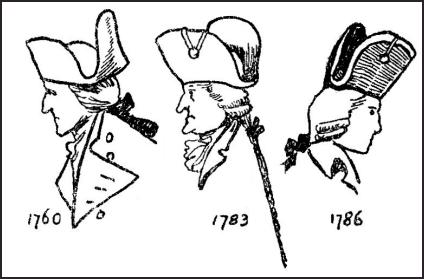
King George III - 1760-1820 English Costume History by Dion Clayton Calthrop Part 1 - Georgian Men's Coats
- A MAN OF THE TIME OF GEORGE III - 1760-1820 (Early)
- MAN OF THE TIME OF GEORGE III - 1760-1820 (Later)
- Men's English Costume Drawings
- DRAWINGS (1768-1820) TO ILLUSTRATE THE COSTUME OF THE REIGN OF GEORGE THE THIRD
GEORGE THE THIRD
Reigned sixty years: 1760-1820. Born 1738. Married, 1761, Charlotte Sophia of Mecklenburg-Strelitz.
Near Left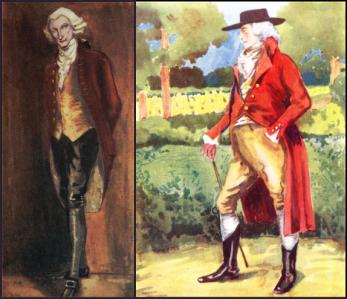 A MAN OF THE TIME OF GEORGE III -1760-1820
A MAN OF THE TIME OF GEORGE III -1760-1820
The full-skirted coat, though still worn, has given way, in general, to the tail-coat. The waistcoat is much shorter. Black silk knee-breeches and stockings are very general.
Right MAN OF THE TIME OF GEORGE III - 1760-1820
The cuffs have gone, and now the sleeve is left unbuttoned at the wrist. The coat is long and full-skirted, but not stiffened. The cravat is loosely tied, and the frilled ends stick out. These frills were, in the end, made on the shirt, and were called chitterlings.THE MEN AND WOMEN
Throughout this long reign the changes of costume are so frequent, so varied, and so jumbled together, that any precise account of them would be impossible. I have endeavoured to give a leading example of most kind of styles in the budget of drawings which goes with this chapter. Details concerning this reign are so numerous: Fashion books, fashion articles in the London Magazine, the St. James's Chronicle, works innumerable on hair-dressing, tailors' patterns - these are easily within the reach of those who hunt the second-hand shops, or are within reasonable distance of a library.DRAWINGS TO ILLUSTRATE THE COSTUME OF THE REIGN OF GEORGE THE THIRD
THE FIRST FORTY-EIGHT DRAWINGS BY THE AUTHOR (Calthrop), AND THE REMAINING TWELVE BY THE DIGHTONS, FATHER AND SON.Men's English Costume Drawings GEORGE III
DRAWINGS 1 & 2

ABOVE - MEN'S COAT DRAWINGS 1 & 2, 1768 -1772.
Calthrop writes:- Following my drawings, you will see in the first the ordinary wig, skirted coat, knee-breeches, chapeau-bras, cravat or waistcoat, of the man about town. I do not mean of the exquisite about town, but, if you will take it kindly, just such clothes as you or I might have worn. In the second drawing we see a fashionable man, who might have strutted past the first fellow in the Park. His hair is dressed in a twisted roll; he wears a tight-brimmed little hat, a frogged coat, a fringed waistcoat, striped breeches, and buckled shoes.Drawings of Georgian Men's Coats 3 & 4 The Macaroni
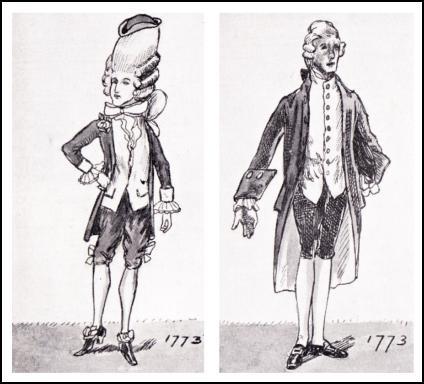
ABOVE - MEN'S COAT DRAWINGS 3 & 4, 1773.
In the third we see the dress of a Macaroni. On his absurd wig he wears a little Nevernoise hat; his cravat is tied in a bow; his breeches are loose, and beribboned at the knee. Many of these Macaronis wore coloured strings at the knee of their breeches, but the fashion died away when Jack Rann, 'Sixteen String Jack,' as he was called after this fashion, had been hung in this make of breeches. In number four we see the development of the tail-coat and the high-buttoned waistcoat. The tail-coat is, of course, son to the frock-coat, the skirts of which, being inconvenient for riding, had first been buttoned back and then cut back to give more play.Drawings of Georgian Men's Coats 5 & 6
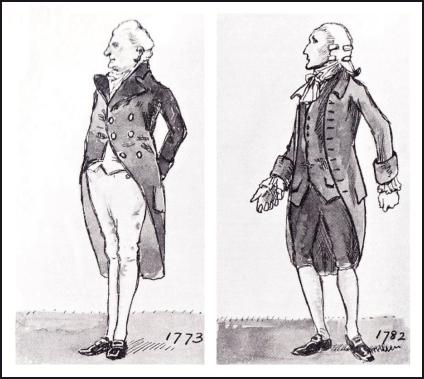
ABOVE - MEN'S COAT DRAWINGS 5 & 6, 1773-1782.
Drawings of Georgian Men's Coats 7 & 8
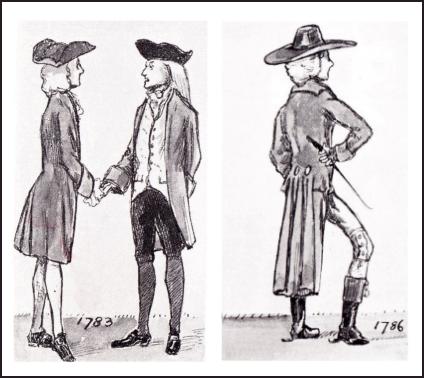
ABOVE - MEN'S COAT DRAWINGS 7 & 8, 1783-1786
Number seven shows how different were the styles at one time. Indeed, except for the Macaroni and other extreme fashions, the entire budget of men as shown might have formed a crowd in the Park on one day about twenty years before the end of the reign. There would not be much powdered hair after 1795, but a few examples would remain. A distinct change is shown in the eighth drawing of the long-tailed, full coat, the broad hat, the hair powdered, but not tied.Drawings of Georgian Men's Coats 9 & 10
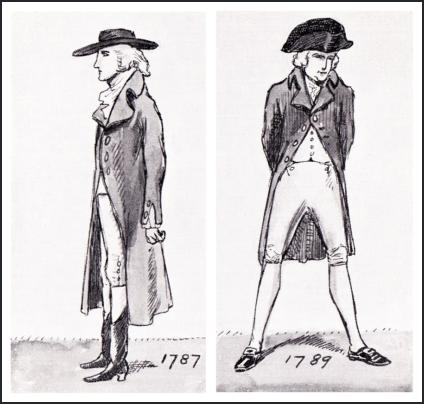
ABOVE - MEN'S COAT DRAWINGS 9 & 10, 1787-1789.
Number nine is another example of the same style. The tenth drawing shows the kind of hat we associate with Napoleon, and, in fact, very Napoleonic garments.§
Drawings of Georgian Men's Coats 11 & 12 - The Zebra
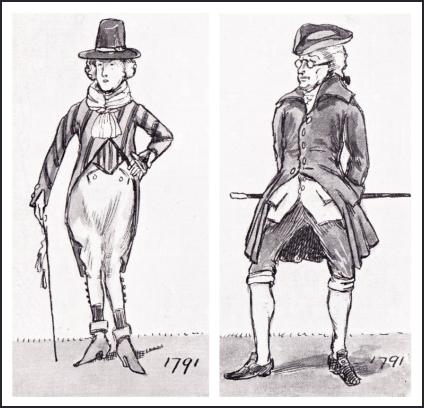
ABOVE - MEN'S COAT DRAWINGS 11 & 12, 1791.
In eleven we have a distinct change in the appearance of English dress. The gentleman is a Zebra, and is so-called from his striped clothes. He is, of course, in the extreme of fashion, which did not last for long; but it shows a tendency towards later Georgian appearance - the top-hat, the shorter hair, the larger neckcloth, the pantaloons - forerunners of Brummell's invention - the open sleeve. Number twelve shows us an ordinary gentleman in a coat and waistcoat, with square flaps, called dog's ears. As the Drawings of Georgian Men's Coats continue you can see that the dress became more and more simple, more like modern evening dress as to the coats, more like modern stiff fashion about the neck.DRAWINGS 13 & 14
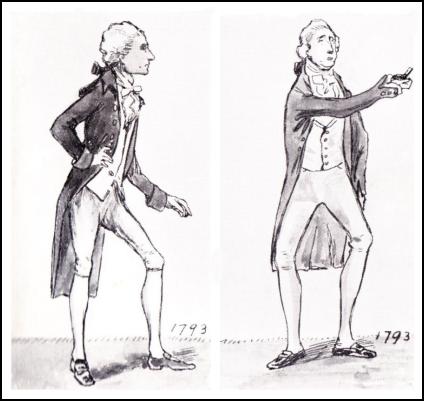
ABOVE - MEN'S COAT Drawings of Georgian Men's Coats 13 & 14, 1793.
DRAWINGS 15 & 16
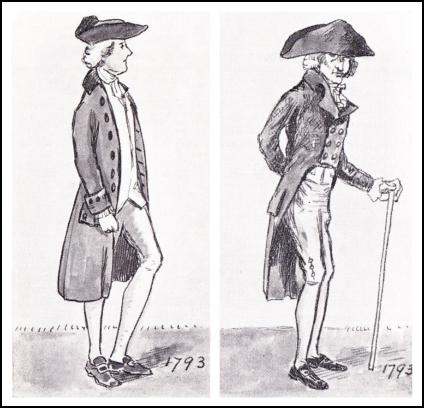
ABOVE - MEN'S COAT DRAWINGS 15 & 16, 1793.
Drawings of Georgian Men's Coats 17 & 18
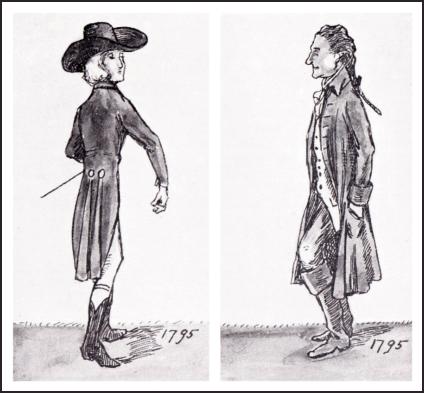
ABOVE - MEN'S COAT DRAWINGS 17 & 18, 1795.
Drawings of Georgian Men's Coats 19 & 20
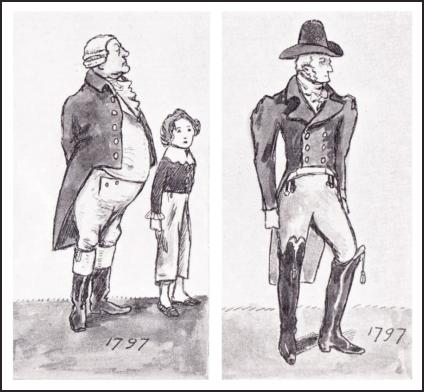
ABOVE - MEN'S COAT DRAWINGS 19 & 20, 1797.
DRAWING 21
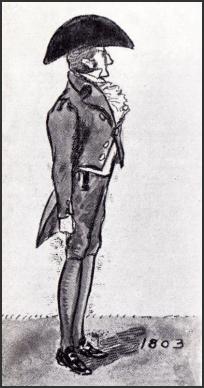
ABOVE - DRAWING OF MAN 1803
Georgian Men's Headwear, Hats, Hairstyles, Wigs & Queues
Mid-Georgian Bag Wigs & Queues Illustration

Men's Neater Hairstyles Illustration

Beaver & Round Hats 1786+ Illustration
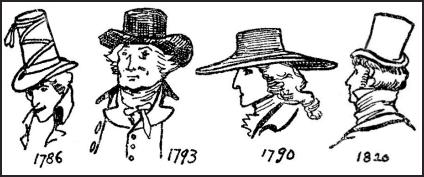
Georgian Women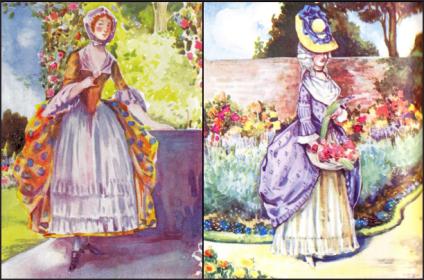
These colour plates show the last of the pannier dresses, which gave way in 1794 or 1795 to Empire dresses. After the French Revolution all dress of both men and women underwent radical changes.
The drawings of the women's dresses should also speak for themselves.
Georgian Wigs
You may watch the growth of the wig and the decline of the hoop - I trust with ease. You may see those towers of hair of which there are so many stories. Those masses of meal and stuffing, powder and pomatum, the dressing of which took many hours. Those piles of decorated, perfumed, reeking mess, by which a lady could show her fancy for the navy by balancing a straw ship on her head, for sport by showing a coach, for gardening by a regular bed of flowers. Heads which were only dressed, perhaps, once in three weeks, and were then rescented because it was necessary. Monstrous germ-gatherers of horse-hair, hemp-wool, and powder, laid on in a paste, the cleaning of which is too awful to give in full detail. 'Three weeks,' says my lady's hairdresser, 'is as long as a head can go well in the summer without being opened.'The Pouter Pigeon Fashion Look
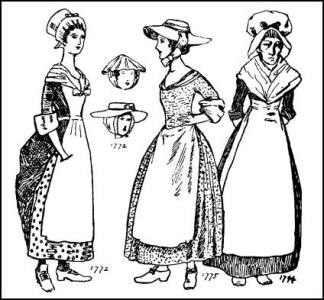 Then we go on to the absurd idea which came over womankind that it was most becoming to look like a pouter pigeon. She took to a buffon, a gauze or fine linen kerchief, which stuck out pigeon-like in front, giving an exaggerated bosom to those who wore it. With this fashion of 1786 came the broad-brimmed hat.
Then we go on to the absurd idea which came over womankind that it was most becoming to look like a pouter pigeon. She took to a buffon, a gauze or fine linen kerchief, which stuck out pigeon-like in front, giving an exaggerated bosom to those who wore it. With this fashion of 1786 came the broad-brimmed hat.
